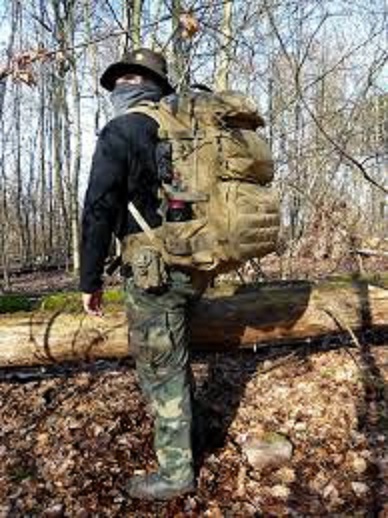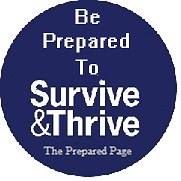Bug-Out Bag List, Does Yours Make Sense?
Bug-out bags are becoming fairly commonplace;with a number of companies producing commercial versions. While the vast majority of the population still doesn’t have one, most have heard of them. Pretty much everyone in the prepping community has one, as well as many people who don’t consider themselves preppers, but still recognize the value in having a bag that’s ready to go, should there be a general evacuation.
While those commercial bug-out bags are available, they usually aren’t your best choice. They are more designed for people who don’t understand how to survive on their own. As such, they follow government guidelines for a bug-out bag, more than they do the practical realities of survival.
I will have to say though, that I’ve seen plenty of home-made bug-out bags which weren’t a whole lot better. They’re too heavy, have the wrong equipment, are designed for different weather and terrain or just don’t match the capabilities of the person who owns them. Any bug-out bag that doesn’t meet your particular needs isn’t really worth having.

image by survivalistprepper.net
Start with Your Plan
Before designing a bug-out bag, you’ve got to design a bug-out plan. Then from that you will have your bug-out bag list.If you don’t have any idea of where you’re going or how you’re going to get there, you really can’t figure out what you’re going to need while you’re on your way and once you get there.
There are lots of different ways of bugging out. If you’re fortunate enough to have a prepared and stocked cabin in the woods for your bug-out retreat, then you only need enough to get you there. That’s a whole lot different than trying to stay alive in the wild, having to build yourself a shelter. If your only bug-out plan is to escape in the case of an evacuation and then go to a government shelter in another town, then you don’t need survival equipment as much as the means to take care of yourself in that shelter.
When you come up with your bug-out plan, think about alternatives as well, in case something goes wrong. Probably the biggest alternative you need to think about is what you’ll do if you can’t drive all the way to your bug-out location. In a general evacuation, the highways will probably turn into parking lots, filled with broken down, overheated and out-of-gas vehicles. In that case, you’ll need to go on foot.
Consider Climate, Terrain, Weather and Distance
The next thing to consider is what you’re going to have to go through to get there. A properly equipped bug-out bag will change through the year. In the winter you’ll need warmer clothes than you need in the summer. Changing clothes to match the seasons will make sure your bag is always ready to go. If you have a rainy season, then you’ll need to make sure you’re ready to deal with it; likewise for a dry season.
What’s the countryside like between where you are and where you’re going? How much water is available? Are there readily accessible food sources such as edible plants and abundant game? If that bug-out bag is going to be the only thing you’re going to have with you, then you’d better make sure that it will provide for your needs. Adjust your load to match those needs: if you’re in an arid area, take extra water.
Think about how far it is from where you live to your bug-out location. How long will it take you to get there, if you’ve got to walk? The average walking speed is 3-1/2 miles per hour; but that’s on flat, paved terrain. If you have to go cross-country, it will be slower. You might also be slowed down by your health and physical condition.
Everyone uses the same standard for their bug-out bag of three days worth of food. That comes from government guidelines. But if it’s going to take you five days to walk to your bug-out retreat, that three days worth of food isn’t enough.
Your Own Training and Ability
Finally, consider your own training and ability. Many a bug-out bag list contain a wide assortment of survival equipment for use in the wild. That equipment is great to have, if you know how to use it. But there’s no reason to carry snare wire with you, if you don’t know how to rig a snare.
Just about every survival instructor recommends practicing your survival skills regularly. When I was first learning about survival, I would go “camping” in the woods for two or three days at a time, using just what was in my survival kit, plus a little food (not even a whole bug-out bag). I did that so that I could practice my survival skills, putting them to use to make sure that I would be able to do them, if I ever needed to.
My personal bug-out bag is heavy on survival equipment; but I know how to use every piece of equipment in it. I’m also heavy on tools, as I want to be able to build myself a shelter, if I ever need to. But that doesn’t mean you should do the same, unless you can use all that equipment.
If you’ve never tried starting a fire with a ferro rod, don’t count on doing so in a survival situation. If you’ve never built a lean-to out of a tarp or survival blanket, don’t think you’ll be able to do so when the wind is blowing and you’re right on the edge of hypothermia. These skills take practice; so practice.
With that in Mind…
Now that we’ve discussed how to decide what’s in your bag, let’s talk about a few basic rules to make sure you have what you need. I’m not going to give you a detailed bug out bag list here, as you can find those anywhere. Besides, I don’t want you to follow my bug-out bag list; I want you to come up with your own.
- Water – There’s no way you can carry enough water with you. You’ll need at least a gallon per day for drinking and cooking. If you’re in a hot climate, that will go up. Make sure you have at least two means of purifying water along with you, as well as containers to carry water you’ve purified.
- Food – Keep it lightweight. I’m big on dehydrated food in my bug-out bag. You won’t find a single canned anything in there. I don’t want to carry one ounce more than I have to. After you put X number of days worth of food in it, add a couple more days worth of high-energy survival bars as a backup.
- First-aid – Many people forget about a first-aid kit or limit it to a few adhesive bandages and some aspirin. My first-aid kit provides me with enough supplies to take care of fairly major trauma, such as broken limbs and gunshot wounds.
- Fire starting – As far as I’m concerned, you can’t have too many fire starters. If you think about it, you’re going to have to start a fire every time to want to eat. That’s three fires per day, times however many days. Carrying ten matches in a waterproof container isn’t going to cut it. Make sure you have some sorts of accelerants as well, such as cotton balls soaked in Vaseline. That way, if you have to start a fire with damp wood, you can still do it.
When it comes to things like cooking utensils and tools, there are three basic rules. The first is light weight. Every ounce you have to carry will take energy and strength. It’s worth spending 20% or 30% more on backpacking cookware that’s made of magnesium, if it will save you a few ounces. The second major rule is to think redundancy. What are you going to use if your knife blade breaks or you lose your hatchet? Finally, think multi-use. That’s a great way of building in both redundancy and saving on weight. Tools that perform multiple tasks help you get more done.
The biggest killer in the wild is hypothermia.
You need to be able to conserve your body heat, especially in cool or cold weather. Don’t just assume that you can suffer from hypothermia in the winter, you can in the summer as well, especially if you fall in the water just before sundown. Make sure that you have adequate means of building a shelter. Even if you have a tent, what’s your backup plan?
Remember, this is your bug-out bag; so it has to work for you. If you can, go out in the woods and spend a weekend with it, just so that you can make sure that everything is going to work out the way you expected it to.
 Please read our disclaimer. We provide you with information from various sites all over the world. The author’s expressed opinion isn’t necessarily that of The Prepared Page or its staff. Our intent is to bring you the information. Use your common sense and your own best judgment when using any information contained within the blogs.
Please read our disclaimer. We provide you with information from various sites all over the world. The author’s expressed opinion isn’t necessarily that of The Prepared Page or its staff. Our intent is to bring you the information. Use your common sense and your own best judgment when using any information contained within the blogs.
While you’re here check out some of those other posts you may find them interesting!!!
Some posts may contain affiliate links








